 Tagliatelle is a traditional pasta from Emilia-Romagna, the region where I live. Tagliatelle is an egg pasta that resembles a long flat ribbon and is very similar to fettuccine, which are made in the same manner but are slightly wider in size. My mother-in-law Patrizia taught me how to make the traditional recipe by hand. (How lucky am I to have an Italian mother-in-law to pass down her secrets to me!) The traditional recipe is made with all-purpose flour or durum wheat semolina. I wanted to make a more nutritious pasta and therefore experimented 14 times (yes 14!) to find the right flours and amounts to create the perfect pasta that you can make entirely by hand or by using a stand still mixer. The winning flours that provided the perfect consistency were whole grain flour and durum wheat semolina.
Tagliatelle is a traditional pasta from Emilia-Romagna, the region where I live. Tagliatelle is an egg pasta that resembles a long flat ribbon and is very similar to fettuccine, which are made in the same manner but are slightly wider in size. My mother-in-law Patrizia taught me how to make the traditional recipe by hand. (How lucky am I to have an Italian mother-in-law to pass down her secrets to me!) The traditional recipe is made with all-purpose flour or durum wheat semolina. I wanted to make a more nutritious pasta and therefore experimented 14 times (yes 14!) to find the right flours and amounts to create the perfect pasta that you can make entirely by hand or by using a stand still mixer. The winning flours that provided the perfect consistency were whole grain flour and durum wheat semolina.
 This Smeg stand mixer is the first one I have every used, and, I can honestly say that, I’m in love. I always thought that stand mixers were a big investment and took up a lot of countertop space; yet, that is so worth the trade off for efficiency in the kitchen. I am always in a race with time, and while this machine mixed my dough I was able to set up my work space, clean some dishes and take some pictures. Plus, I honestly don’t mind having this Smeg stand mixer on my countertops as the 1950’s design is absolutely gorgeous and adds an element of style to my kitchen.
This Smeg stand mixer is the first one I have every used, and, I can honestly say that, I’m in love. I always thought that stand mixers were a big investment and took up a lot of countertop space; yet, that is so worth the trade off for efficiency in the kitchen. I am always in a race with time, and while this machine mixed my dough I was able to set up my work space, clean some dishes and take some pictures. Plus, I honestly don’t mind having this Smeg stand mixer on my countertops as the 1950’s design is absolutely gorgeous and adds an element of style to my kitchen.
 After you have mixed up the ingredients, it is important to divide the dough into two balls, wrap them in plastic wrap and store in the refrigerator for at least 1/2 hour. Then divide the dough into four equal parts, pat them into a rectangle shape and flour them well.
After you have mixed up the ingredients, it is important to divide the dough into two balls, wrap them in plastic wrap and store in the refrigerator for at least 1/2 hour. Then divide the dough into four equal parts, pat them into a rectangle shape and flour them well.
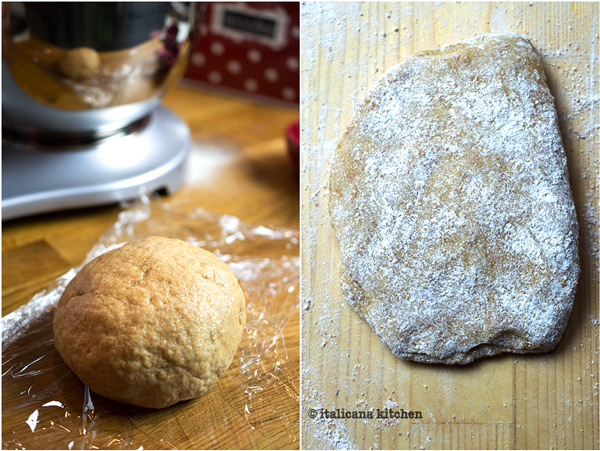 Flour the pasta roller accessory and run one piece of dough through it on setting 0 at speed 1 (the slowest.) Fold the dough over and pass it through again. Repeat another time. Continue to run the dough through the machine several times reducing the thickness from 0 to 5.
Flour the pasta roller accessory and run one piece of dough through it on setting 0 at speed 1 (the slowest.) Fold the dough over and pass it through again. Repeat another time. Continue to run the dough through the machine several times reducing the thickness from 0 to 5.
 Repeat for all of the sheets of pasta, adding more flour each time to the pasta roller accessory.
Repeat for all of the sheets of pasta, adding more flour each time to the pasta roller accessory.
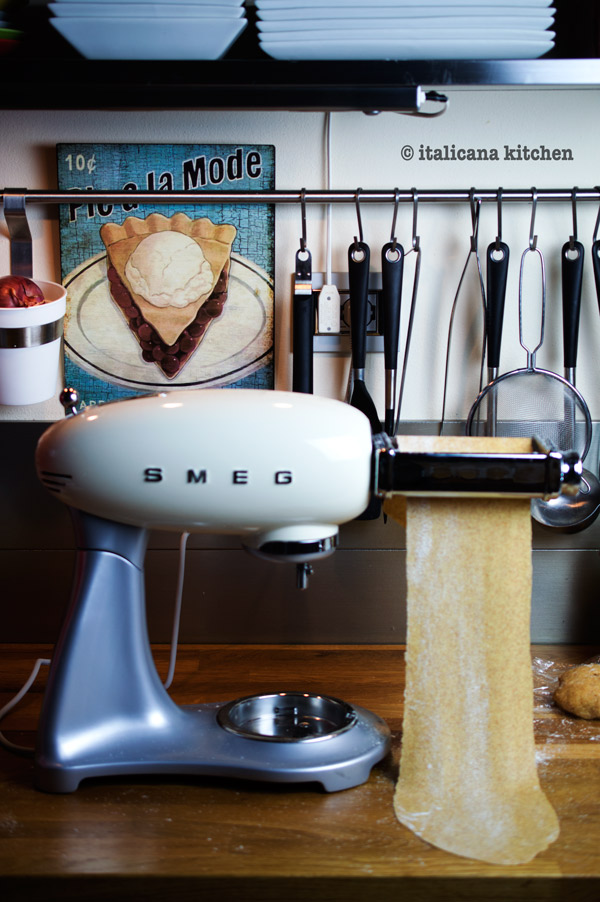 Generously flour a large wooden board and place the pasta sheets on top. Generously flour both top and bottom of the pasta sheets. If you don’t flour them enough, the pasta will stick to itself when rolled and will be impossible to unroll.
Generously flour a large wooden board and place the pasta sheets on top. Generously flour both top and bottom of the pasta sheets. If you don’t flour them enough, the pasta will stick to itself when rolled and will be impossible to unroll.
 To easily unroll the tagliatelle ribbons, here is a little trick: instead of rolling the pasta sheet only to one side, roll both sides towards the middle, then even out the edges with a knife.
To easily unroll the tagliatelle ribbons, here is a little trick: instead of rolling the pasta sheet only to one side, roll both sides towards the middle, then even out the edges with a knife.
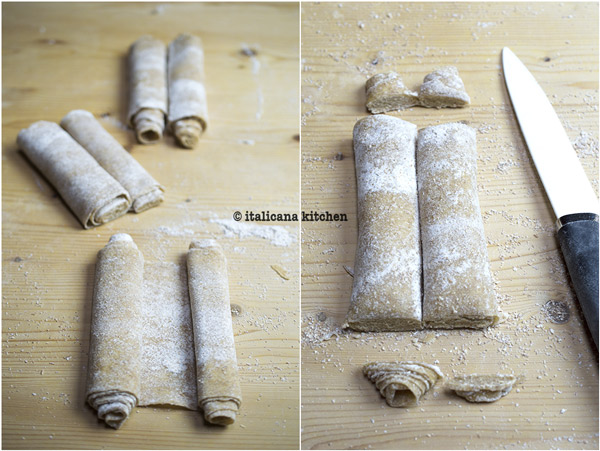 Slice the noodles so that they are 1/4 inch (10mm) and slide the knife under the pasta sheet.
Slice the noodles so that they are 1/4 inch (10mm) and slide the knife under the pasta sheet.
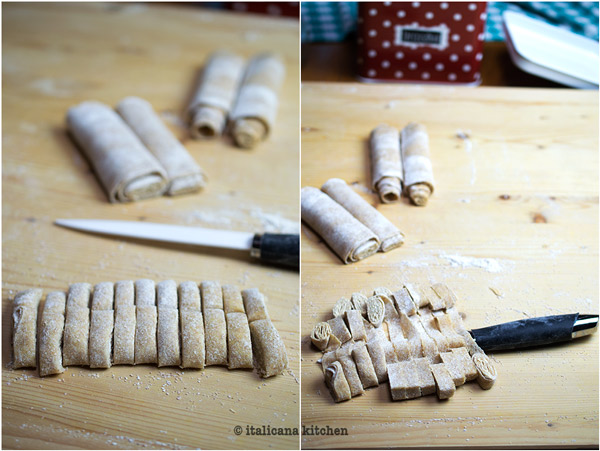 Lift up with the sharp part of the knife pointing downwards so it doesn’t cut through the pasta sheet, and carefully unravel any pasta curls that didn’t automatically fall to the board.
Lift up with the sharp part of the knife pointing downwards so it doesn’t cut through the pasta sheet, and carefully unravel any pasta curls that didn’t automatically fall to the board.
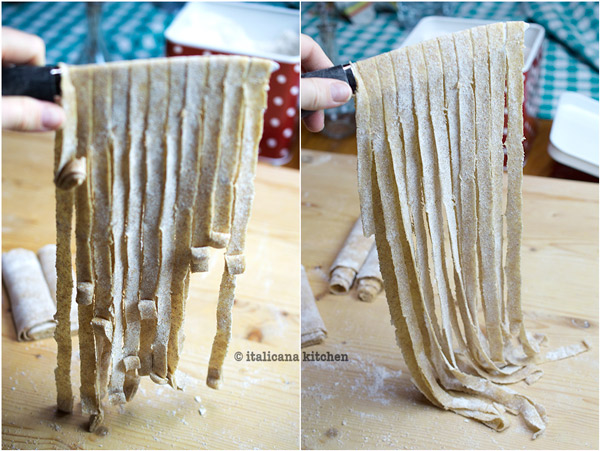 Lay out the pasta ribbons on the floured board. Take 3-4 ribbons in one hand and roll around your fingers as if you were rolling up a cord.
Lay out the pasta ribbons on the floured board. Take 3-4 ribbons in one hand and roll around your fingers as if you were rolling up a cord.
 When all of the pasta has been loosely wrapped around your fingers, gently set it down on the floured board. These little clusters of pasta are called “nidi” in Italian, or “nests”, since they resemble bird nests. Repeat with the remaining dough.
When all of the pasta has been loosely wrapped around your fingers, gently set it down on the floured board. These little clusters of pasta are called “nidi” in Italian, or “nests”, since they resemble bird nests. Repeat with the remaining dough.
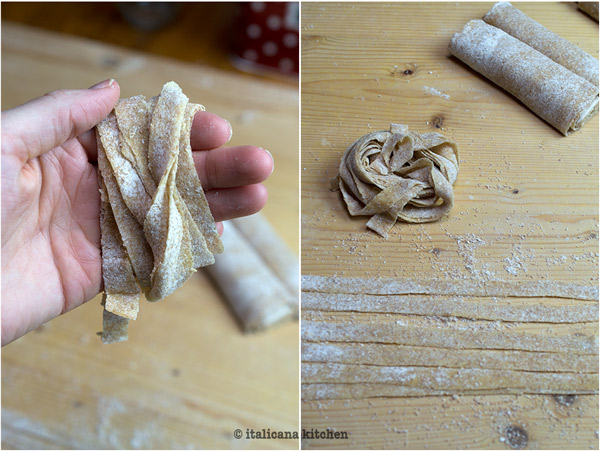 It is usually recommended to allow fresh pasta to dry for a few hours before cooking; however, I couldn’t wait that long and tried cooking the pasta right after I made these and it turned out great.
It is usually recommended to allow fresh pasta to dry for a few hours before cooking; however, I couldn’t wait that long and tried cooking the pasta right after I made these and it turned out great.
 The trick to a good Italian pasta is to generously salt the water after it is boiling; Mr. Italicano always notices if I forgot. This fresh tagliatelle only takes a few minutes to cook. I usually check after 2 minutes and every minute after until ready. The pasta should be “al dente” or slightly firm when bitten into.
The trick to a good Italian pasta is to generously salt the water after it is boiling; Mr. Italicano always notices if I forgot. This fresh tagliatelle only takes a few minutes to cook. I usually check after 2 minutes and every minute after until ready. The pasta should be “al dente” or slightly firm when bitten into.
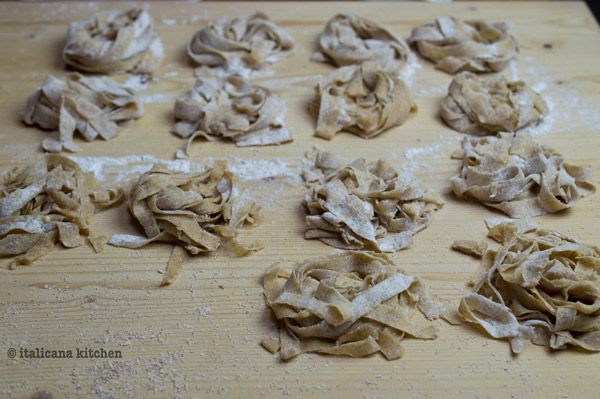 The tagliatelle can be stored in the refrigerator for 1 day max, or you can freeze them. The best way to store them in the freezer is to put them on a cookie sheet so that they are not touching. Tuck them in the freezer until frozen, otherwise they will stick together, then you can place them in plastic bags, one on top of the other and take out the quantity you want as needed. Two little nests are 1 portion size.
The tagliatelle can be stored in the refrigerator for 1 day max, or you can freeze them. The best way to store them in the freezer is to put them on a cookie sheet so that they are not touching. Tuck them in the freezer until frozen, otherwise they will stick together, then you can place them in plastic bags, one on top of the other and take out the quantity you want as needed. Two little nests are 1 portion size.
- 1¾ cups (210g) whole grain flour
- ½ cup + 2 tablespoons (90g) durum wheat semolina
- 3 large eggs (2.2-2.4 ounces each)
- 2 pinches unrefined salt
- 1 tablespoon extra virgin olive oil
- Attach the dough hook to the stand mixer and add the flours, eggs, salt and extra virgin olive oil. Mix on speed 1 for five minutes. Stop the mixer and push against the dough with your finger. If it leaves an imprint (like a ripe peach) and doesn’t stick to your finger, it’s ready. If the dough, however, is sticky turn the stand mixer back on and gradually add a little more flour, stopping every so often to check the consistency until it no longer sticks to your finger.
- If don’t have a stand mixer, follow the same procedure but knead by hand until the dough is homogenous, leaves an imprint when poked and isn’t sticky.
- Divide the dough into two balls and wrap each one individually with some plastic wrap; place in the refrigerator for 30 minutes.
- Attach the pasta roller accessory and sprinkle some flour on top. Divide each ball into two pieces (four pieces total), shape them into flat rectangles and flour generously on top and bottom. Pass one of the pieces through the machine on speed 1. Fold it back over on itself, and pass it through again. Repeat one more time before moving on to the next level of thickness. Pass the dough several times reducing the thickness from no. 0 to 5.
- Generously flour a large wooden board and lay the pasta sheets on top as you roll them out.
- If you are rolling out the dough with a rolling pin, it will be easier to divide the dough into two pieces and roll each one out on a generously floured wooden board. The dough should be rolled out thin enough that when you hold the dough up against a light you can see the light almost pass through.
- Roll each side of the pasta sheet towards the center. Even off the ends with a knife but don’t throw away these scraps, you can stick them in the middle of the little pasta nests.
- Slice the noodles so that they are ¼ inch (10mm) and slide the knife under the pasta sheet.
- Lift up with the sharp part of the knife pointing down so it doesn’t cut through the pasta sheet, and carefully unravel any pasta curls that didn’t automatically fall to the board.
- Lay out the pasta ribbons on a generously floured board. Take 3-4 ribbons in one hand and roll them around your fingers as if you were rolling up a cord.
- When all of the pasta has been loosely wrapped around your fingers, gently set it down on the floured board. These little clusters of pasta are called “nidi” in Italian, or “nests”, since they resemble bird nests. Repeat with the remaining dough.
- It is usually recommended to allow fresh pasta to dry for a few hours before cooking; however, I couldn’t wait that long and tried cooking the pasta right after I made these and it turned out great.
- Bring a large pot of water to boil; add course salt then dump the tagliatelle inside. Cook for 2-3 minutes then check one to see if one is ready. The pasta should be “al dente” or slightly firm. If it is not ready, continue to cook for 1 minute and check again. Drain and serve with your sauce of choice and a big sprinkle of freshly grated Parmesan cheese.
- Conservation
- The tagliatelle can be stored in the refrigerator for 1 day max, or you can freeze them. The best way to store them in the freezer is to put them on a cookie sheet so that they are not touching. Tuck them in the freezer until frozen, otherwise they will stick together, then you can place them in plastic bags, one on top of the other and take out the quantity you want as needed. Two little nests are 1 portion size.

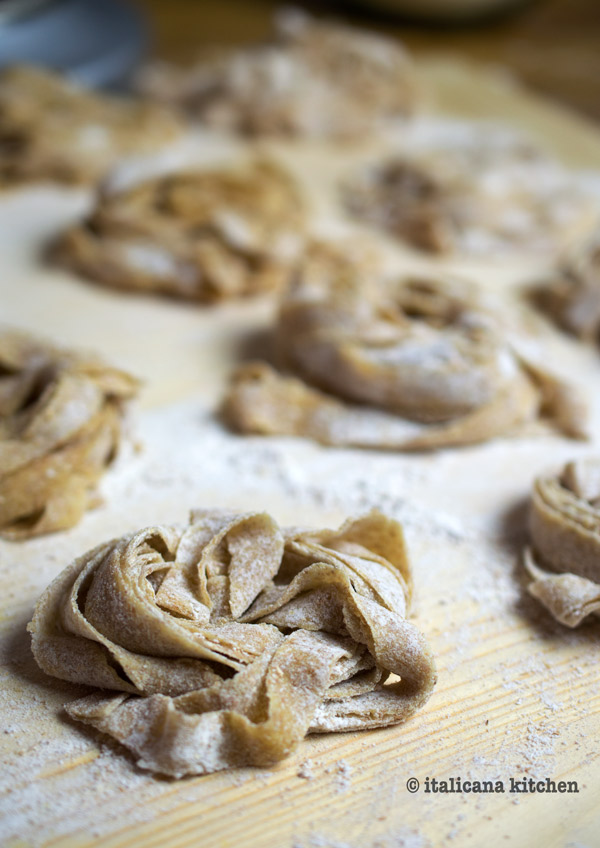
Would like to be on e-mail list if you have one
Hi Barby, Thank you for your interest! I have just signed you up to my email list. Please check your inbox to confirm the sign up and if you have any problems or questions, just let me know! Thanks! Cindy